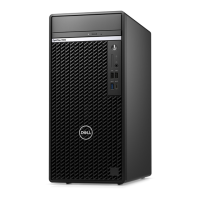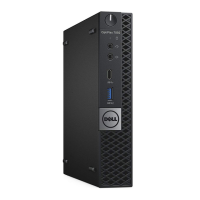How to fix 'Invalid Configuration Information' on Dell Desktop?
- PproctorcoreySep 23, 2025
To resolve 'Invalid Configuration Information' on your Dell Desktop, correct the appropriate options in the system setup program.
How to fix 'Invalid Configuration Information' on Dell Desktop?
To resolve 'Invalid Configuration Information' on your Dell Desktop, correct the appropriate options in the system setup program.
What to do if my Dell Desktop says 'Operating System Not Found'?
If your Dell Desktop displays the error message 'Operating System Not Found', reinstall the operating system. If the problem persists, contact Dell.
What to do if my Dell Desktop says 'No Boot Device Available'?
If your Dell Desktop displays 'No Boot Device Available', and you're using the hard drive as your boot device, make sure the drive is installed correctly, properly seated, and partitioned as a boot device.
How to fix 'Hard-Disk Drive Failure' on Dell Desktop?
To fix a hard-disk drive failure on your Dell Desktop: Shut down the computer, remove the hard drive, and boot the computer from an optical drive. Then, shut down the computer again, reinstall the hard drive, and restart the computer. If the problem continues, try using another drive. Also, run the Hard Disk Drive tests in Dell Diagnostics.
How to fix 'Hard-Disk Drive Configuration Error' on Dell OptiPlex 7070?
To resolve a hard-disk drive configuration error on your Dell Desktop: Shut down the computer, remove the hard drive, and boot the computer from an optical drive. Then, shut down the computer, reinstall the hard drive, and restart the computer. Run the Hard Disk Drive tests in Dell Diagnostics.
What to do if my Dell OptiPlex 7070 says 'Disk C: Failed Initialization'?
If your Dell Desktop displays the error 'Disk C: Failed Initialization', run the hard drive tests in Dell Diagnostics.
How to fix 'Shutdown Failure' on Dell OptiPlex 7070 Desktop?
To fix a shutdown failure on your Dell Desktop, run the System Set tests in Dell Diagnostics. If the message reappears, contact Dell.
How to fix 'Sector Not Found' on Dell OptiPlex 7070?
To fix a 'Sector Not Found' error on your Dell Desktop, run the Windows error-checking utility to check the file structure on the hard drive.
What does 'Auxiliary Device Failure' mean on my Dell OptiPlex 7070 and how do I fix it?
If you're getting an 'Auxiliary Device Failure' message on your Dell Desktop, the touchpad or external mouse may be faulty. For an external mouse, check the cable connection. You can also enable the Pointing Device option in the System Setup program.
How to fix 'Keyboard Controller Failure' on Dell OptiPlex 7070 Desktop?
To fix a keyboard controller failure on your Dell Desktop, check the cable connection if you're using an external keyboard. Restart the computer, and avoid touching the keyboard or the mouse during the boot routine. Run the Keyboard Controller test in Dell Diagnostics.
Safety guidelines for working with the computer to prevent damage and ensure personal safety.
Steps to take before performing internal computer operations, including saving work and disconnecting power.
General safety measures for handling computer components during disassembly or reassembly.
Methods and precautions to prevent damage to sensitive electronic components from static electricity.
Description of the components and proper use of an ESD field service kit for protection.
Proper methods for safely transporting static-sensitive components, such as using anti-static bags.
Steps to take after completing internal maintenance, including replacing parts and connecting devices.
Details on DDR4 memory technology, its specifications, and differences from previous generations.
Overview of Universal Serial Bus capabilities, speed modes, applications, and historical evolution.
Covers the USB Type-C connector, Alternate Mode, Power Delivery, and compatibility with USB 3.1.
Features and advantages of the HDMI 2.0 digital audio/video interface.
Information on Intel Optane memory, its function as a storage accelerator, requirements, and configuration.
Procedure for removing and installing the computer's side cover.
Steps to remove and install an expansion card from its slot.
Instructions for removing and installing the coin cell battery from the system board.
Procedure for removing and installing the hard drive assembly.
Steps to remove and install the computer's hard drive from its bracket.
Instructions for removing and installing the front bezel.
Procedure for removing and installing the combined hard drive and optical drive module.
Steps to remove and install the optical drive.
Instructions for removing and installing memory modules from the system board.
Procedure for removing and installing the heatsink fan.
Steps to remove and install the heatsink assembly.
Instructions for removing and installing the system intrusion switch.
Procedure for removing and installing the power switch.
Steps to remove and install the computer's processor.
Instructions for removing and installing an M.2 PCIe SSD.
Procedure for removing and installing the power supply unit.
Steps to remove and install the system speaker.
Instructions for removing and installing the system board.
Overview of the ePSA diagnostic tool for comprehensive hardware checks.
Step-by-step instructions to initiate and perform ePSA diagnostics.
Explanation of Power-On Self Test (POST) and system diagnostics.
List and descriptions of specific error codes encountered during diagnostics.
List and descriptions of system-level error messages and their meanings.
Information on how to contact Dell support for sales, technical, or customer service issues.
Safety guidelines for working with the computer to prevent damage and ensure personal safety.
Steps to take before performing internal computer operations, including saving work and disconnecting power.
General safety measures for handling computer components during disassembly or reassembly.
Methods and precautions to prevent damage to sensitive electronic components from static electricity.
Description of the components and proper use of an ESD field service kit for protection.
Proper methods for safely transporting static-sensitive components, such as using anti-static bags.
Steps to take after completing internal maintenance, including replacing parts and connecting devices.
Details on DDR4 memory technology, its specifications, and differences from previous generations.
Overview of Universal Serial Bus capabilities, speed modes, applications, and historical evolution.
Covers the USB Type-C connector, Alternate Mode, Power Delivery, and compatibility with USB 3.1.
Features and advantages of the HDMI 2.0 digital audio/video interface.
Information on Intel Optane memory, its function as a storage accelerator, requirements, and configuration.
Procedure for removing and installing the computer's side cover.
Steps to remove and install an expansion card from its slot.
Instructions for removing and installing the coin cell battery from the system board.
Procedure for removing and installing the hard drive assembly.
Steps to remove and install the computer's hard drive from its bracket.
Instructions for removing and installing the front bezel.
Procedure for removing and installing the combined hard drive and optical drive module.
Steps to remove and install the optical drive.
Instructions for removing and installing memory modules from the system board.
Procedure for removing and installing the heatsink fan.
Steps to remove and install the heatsink assembly.
Instructions for removing and installing the system intrusion switch.
Procedure for removing and installing the power switch.
Steps to remove and install the computer's processor.
Instructions for removing and installing an M.2 PCIe SSD.
Procedure for removing and installing the power supply unit.
Steps to remove and install the system speaker.
Instructions for removing and installing the system board.
Overview of the ePSA diagnostic tool for comprehensive hardware checks.
Step-by-step instructions to initiate and perform ePSA diagnostics.
Explanation of Power-On Self Test (POST) and system diagnostics.
List and descriptions of specific error codes encountered during diagnostics.
List and descriptions of system-level error messages and their meanings.
Information on how to contact Dell support for sales, technical, or customer service issues.
| Bus type | OPI |
|---|---|
| Tjunction | 100 °C |
| Processor cache | 6 MB |
| Processor cores | 4 |
| Processor model | i5-8265U |
| System bus rate | 4 GT/s |
| Processor family | Intel® Core™ i5 |
| Processor socket | BGA 1528 |
| Processor threads | 8 |
| Processor codename | Whiskey Lake |
| Configurable TDP-up | 25 W |
| Processor frequency | 1.6 GHz |
| Processor cache type | Smart Cache |
| Configurable TDP-down | 10 W |
| Processor lithography | 14 nm |
| Processor manufacturer | Intel |
| PCI Express slots version | 3.0 |
| Processor boost frequency | 3.9 GHz |
| Processor operating modes | 64-bit |
| PCI Express configurations | 1x4, 2x2 |
| Thermal Design Power (TDP) | 15 W |
| Configurable TDP-up frequency | 1.8 GHz |
| Number of processors installed | 1 |
| Configurable TDP-down frequency | 0.8 GHz |
| Maximum number of PCI Express lanes | 16 |
| Memory types supported by processor | DDR4-SDRAM, LPDDR3-SDRAM |
| Memory clock speeds supported by processor | 2133 MHz |
| Memory bandwidth supported by processor (max) | 37.5 GB/s |
| Maximum internal memory supported by processor | 32 GB |
| Discrete graphics card | No |
| On-board graphics card | Yes |
| On-board graphics card ID | 0x3EA0 |
| Discrete graphics card model | Not available |
| On-board graphics card model | Intel® UHD Graphics |
| On-board graphics card OpenGL version | 4.5 |
| On-board graphics card base frequency | 300 MHz |
| On-board graphics card DirectX version | 12.0 |
| On-board graphics card dynamic frequency (max) | 1100 MHz |
| Number of displays supported (on-board graphics) | 3 |
| SSD capacity | The Solid State Drive's storage capacity in Gigabytes. |
| SSD interface | NVMe, PCI Express |
| Storage media | SSD |
| SSD form factor | M.2 |
| Total storage capacity | 256 GB |
| Memory slots | 2x SO-DIMM |
| Internal memory | 8 GB |
| Memory channels | Dual-channel |
| Memory clock speed | 2666 MHz |
| Internal memory type | DDR4-SDRAM |
| Maximum internal memory | 64 GB |
| Memory layout (slots x size) | 1 x 8 GB |
| Cabling technology | 10/100/1000Base-T(X) |
| Top Wi-Fi standard | Wi-Fi 6 (802.11ax) |
| WLAN controller model | Intel Wi-Fi 6 AX200 |
| Ethernet LAN data rates | 10, 100, 1000 Mbit/s |
| USB 2.0 ports quantity | 0 |
| USB 3.2 Gen 2 (3.1 Gen 2) Type-A ports quantity | 2 |
| Chassis type | UFF |
| Product color | Black |
| Cable lock slot type | Kensington |
| Audio chip | Realtek ALC3204-CG |
| Product type | Mini PC |
| Trial software | Microsoft Office 30 day |
| Operating system language | ENG, ESP, FRE |
| Compatible operating systems | Linux |
| Power supply | 65 W |
| Power supply input voltage | 100 - 240 V |
| Power supply input frequency | 50 - 60 Hz |
| Operating shock | 110 G |
| Operating altitude | -15.2 - 3048 m |
| Non-operating shock | 160 G |
| Operating vibration | 0.66 G |
| Non-operating altitude | -15.2 - 10668 m |
| Non-operating vibration | 1.3 G |
| Storage temperature (T-T) | -40 - 65 °C |
| Operating temperature (T-T) | 0 - 35 °C |
| Storage relative humidity (H-H) | 0 - 95 % |
| Operating relative humidity (H-H) | 10 - 90 % |
| Keyboard language | - |
| Processor ARK ID | 149088 |
| Processor package size | 46x24 mm |
| Supported instruction sets | AVX 2.0, SSE4.1, SSE4.2 |
| Intel Identity Protection Technology version | 1.00 |
| Intel Stable Image Platform Program (SIPP) version | 0.00 |
| Depth | 19.7 mm |
|---|---|
| Width | 96.1 mm |
| Height | 256.2 mm |
| Weight | 650 g |











